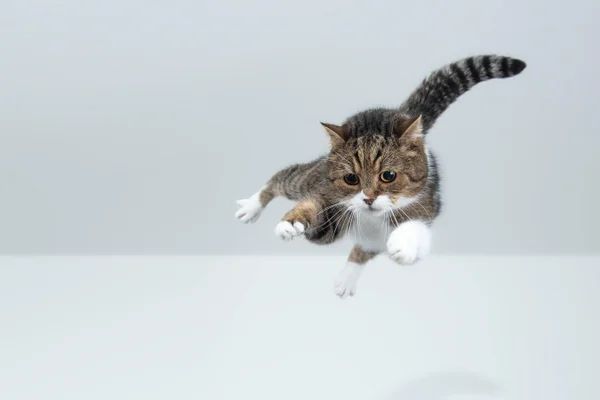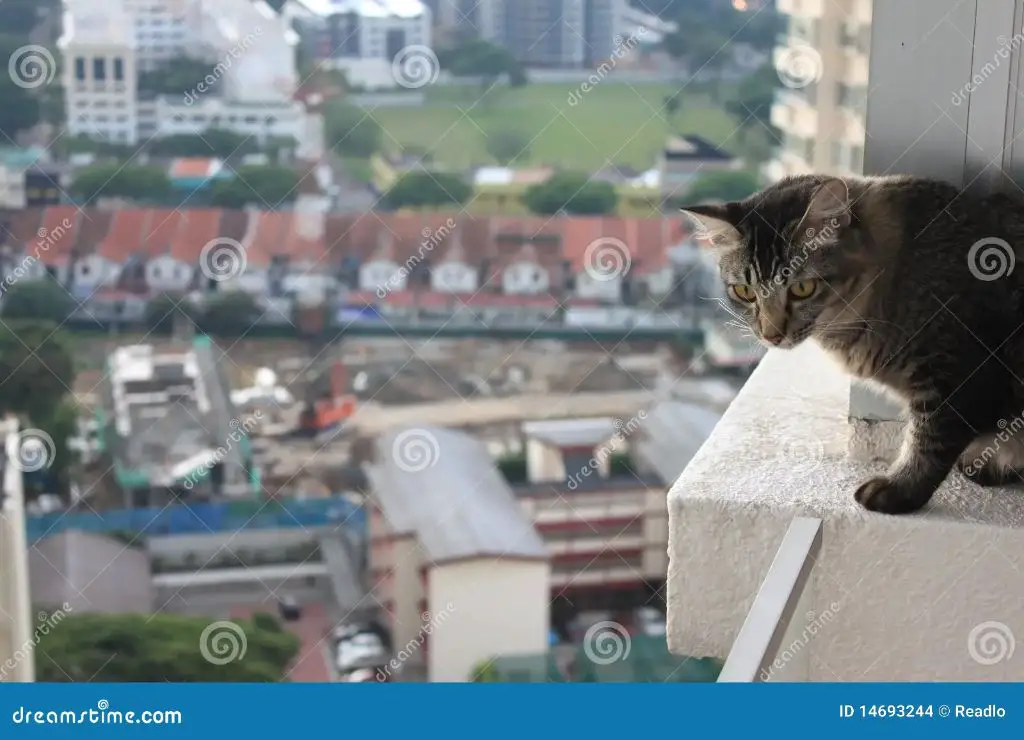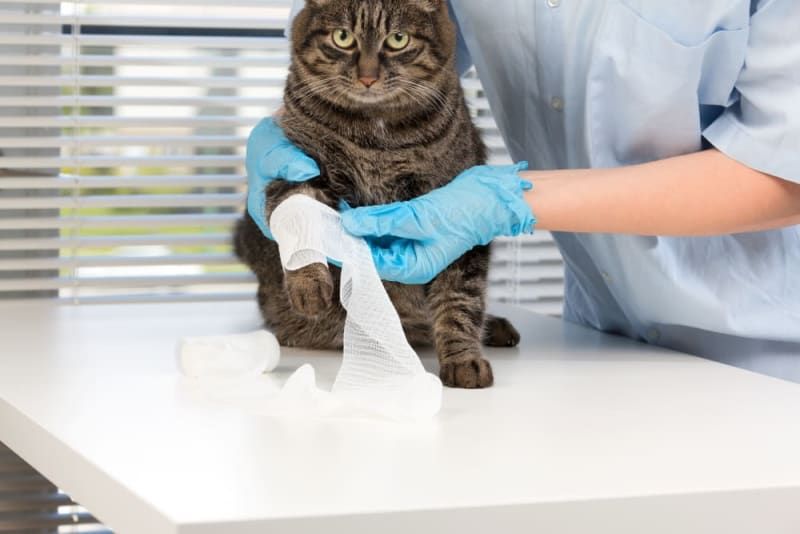High-rise syndrome is a term used to describe injuries sustained by cats falling from heights, typically higher than two stories or 7-9 meters (23-30 feet). It refers to the common set of injuries cats can suffer when falling from balconies, windows, or other elevated surfaces in high-rise buildings [1].
This condition is frequently seen by veterinarians in urban areas where there are many tall apartment buildings. Studies have shown that cats falling from higher than two stories are more likely to suffer severe injuries compared to shorter falls [2]. Understanding high-rise syndrome is important for cat owners to prevent accidents and properly care for their cats.
Why Cats Jump
Cats are naturally curious animals and have an instinct to chase small prey like birds or insects. Their keen senses allow them to spot potential prey that humans often miss. This prey drive can lead cats to jump off balconies while in pursuit of something that has caught their attention.

Cats are agile hunters and will often leap high into the air to catch birds in flight. If they spot a bird or bug near an open balcony, their instincts may take over and cause them to jump without considering the danger.
In addition, cats love exploring their environments and seeking out high vantage points. Balconies can seem like ideal spots for cats to survey their territories. However, their curiosity may lead them to the balcony’s edge to get a better view, where they could unintentionally fall or jump.
References:
[1] https://raleighncvet.com/cat-care/will-my-cat-jump-off-the-balcony
From Which Heights
Cats can survive jumps from relatively low heights without injury. According to research, cats can jump down from heights of up to 10 feet and land unharmed thanks to having flexible bodies and being able to right themselves in the air.
However, jumps from greater heights are far more dangerous. There is a distinction between low-rise and high-rise jumps. Low-rise jumps are from 1-2 stories high (up to around 20 feet), while high-rise refers to falls from 3 stories or higher (over 30 feet). High-rise falls almost always result in severe injuries or death.

One study on high-rise syndrome found the average survival rate for cats falling from 2-6 stories was 90%, but dropped to only 37% for cats falling 7-32 stories. Falls from 7 or more stories resulted in grave injuries like skull fractures, ruptured lungs, and other severe trauma.
Extent of Injuries
Cats that fall from high balconies can suffer severe injuries, even if they land on their feet. According to the ASPCA, high-rise falls are dangerous because cats can reach speeds of up to 60 mph as they fall, so the impact is strong enough to cause severe damage (ASPCA).
Common injuries from high balcony falls include:
- Broken bones – Cats often fracture legs, paws, jaws, and pelvises from the impact.
- Ruptured organs – The liver, lungs, and bladder may rupture internally.
- Traumatic brain injury – Falls can cause brain swelling, hemorrhage, and concussion.
- Chest and abdominal injuries – Blunt force trauma can puncture lungs or damage the diaphragm.
- Spinal injury – Disk rupture and spinal fractures may occur.
According to veterinarians, injuries from high-rise falls require immediate emergency care to treat shock, pain, and internal bleeding (Raleigh NC Vet). While some cats may appear unharmed at first, severe internal damage is common and can be fatal if left untreated. Preventing access to balconies is the best way to avoid these devastating injuries.
Fatalities
The mortality rate for cats that have fallen from high-rises can range from 4% to as high as 27% according to some studies. One study analyzing 92 cats brought to a veterinary clinic after falling 2 to 32 stories showed an overall survival rate of 90% (1). However, mortality increased for cats falling from 7 stories and higher, reaching 67% for cats falling more than 26 stories (2). The injuries sustained from long falls, such as pulmonary contusions, pneumothorax, limb fractures, head trauma, and thoracic trauma can prove fatal despite medical treatment in some cases.

(1) https://en.wikipedia.org/wiki/High-rise_syndrome
Prevention
There are several tips and methods that can help prevent cats from jumping off balconies:
Installing secure balcony enclosures or cat-proof netting can physically block cats from being able to jump off the balcony. According to https://www.themakeupdummy.com/2019/09/26/must-haves-cat-proof-balcony/, netting can be an affordable and effective balcony enclosure option.
Cat deterrents like motion-activated devices that spray water or air can startle cats away from the balcony edge when they approach. Strategically placed items like balloons or foil sheets may also help deter jumps.
Providing plenty of stimulating indoor play opportunities and vertical spaces like cat trees can help prevent boredom and the desire to explore the balcony. Keeping cats entertained inside reduces the urge to jump off the balcony.
Training cats to stay away from the balcony using rewards like treats when they move away from the edge can reinforce the desired behavior. With patience and consistency, cats can learn that the balcony is off-limits.
Ultimately, keeping cats 100% indoors in a high-rise building is the only way to fully eliminate the risk of balcony jumps. But with some effort, cat parents can take steps to significantly reduce the chances of it happening.
Balcony Enclosures
There are several types of cat-safe balcony enclosures available to prevent cats from jumping off balconies. These enclosures allow cats to enjoy fresh air and the view outdoors while keeping them safely contained.
Pre-designed cat enclosure kits like those from Habitat Haven (https://habitathaven.com/collections/pre-designed-cat-enclosure-kits) are an easy option. These catio enclosures come with all the materials and can be configured to fit your balcony size and shape.
Another option is balcony cat fencing from companies like ProtectaPet (https://protectapet.com/en-us/collections/cat-balconies). Their cat-proof balcony mesh can be installed as railing attachments or full enclosures. This flexible netting encloses the balcony while still allowing light and views.
For a custom DIY solution, many pet owners build their own cat balconies using materials like plexiglass, wire mesh, brackets and framing. This allows full customization for more unique balcony shapes and sizes. Proper installation is important to ensure structural integrity and cat safety.
Whether choosing a pre-made kit or building your own custom cat balcony enclosure, the goal is keeping your curious cat safely contained while still letting them experience the outdoors. The right enclosure provides peace of mind while enhancing their environment.
Training
Training cats not to jump off balconies can be challenging, but not impossible. Here are some tips to discourage balcony jumping:
Use positive reinforcement – When your cat is calmly resting inside, reward them with treats and praise. This helps reinforce good behavior.
Block access – Use screens, netting, or plexiglass on railings to physically prevent access. This removes the temptation and opportunity.
Distract and redirect – Redirect your cat’s energy with interactive play when they seem fixated on the balcony. Engage their hunting instincts.
Add deterrents – Use motion sensor devices that spook cats away from railings. Or apply double sided sticky tape that cats dislike.
Consider leashes – With supervision, leash training allows balcony access without the risk. But don’t leave alone.
Patience and consistency are key. It takes time to shape behavior. Stay calm yet firm and reward good choices.
Indoor Cats
There are many benefits to keeping cats indoors. According to the American Humane Society article, indoor cats live longer, averaging 10-15 years, whereas outdoor cats live on average 2-5 years. Indoor cats are also safer from cars, predators, diseases, parasites, and cruel people. Owners have more opportunities to play with and bond with an indoor cat.
However, there are also challenges to keeping cats indoors. Cats have natural instincts to roam, hunt, and explore their territory. Keeping them confined can lead to boredom, frustration, stress, and obesity if they do not get enough stimulation and exercise. Indoor cats require environmental enrichment with toys, cat trees/perches, and opportunities for supervised outdoor access. Owners need to provide daily playtime and affection. Overall, the benefits outweigh the risks for most cats.
Conclusion
In conclusion, cat falls from heights are a serious concern for owners. Cats are naturally inquisitive and have excellent balance, but lack fear of heights. They can survive falls from as high as 10 stories, but risk severe injuries like shattered jaws, ruptured lungs, and broken limbs.
To prevent balcony falls, cat owners have options like installing screening, training cats to avoid the edge, and keeping cats indoors. With some simple precautions, owners can let their cats enjoy balcony view safely.

While falls are scary, we don’t need to lock cats away. Just remain vigilant of risks, know prevention options, and remember that cats’ amazing agility can also save them from high falls under the right conditions.

